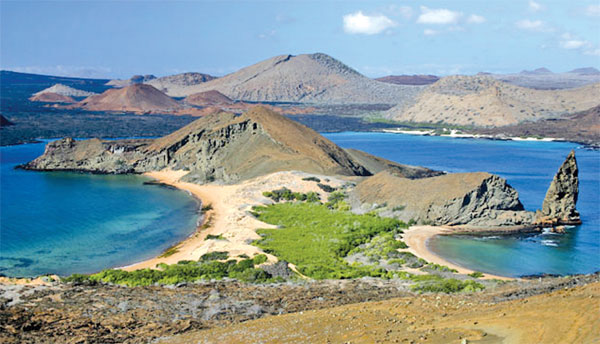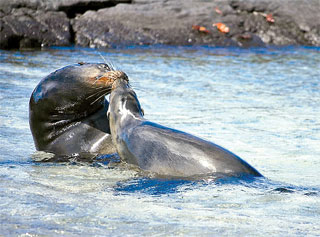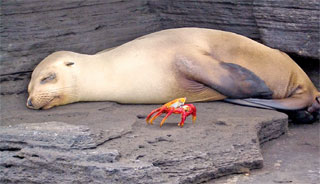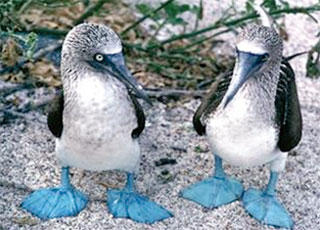The unique Galapagos islands
|

The Galapagos Islands where Charles Darwin found examples for
his study on the Theory of Evolution |
The site is situated on the Galápagos Submarine Platform and consists
of about 120 islands. The larger islands are Isabela, Santa Cruz,
Fernandina, Santiago and San Cristobal. The islands were formed by
volcanic processes and most represent the summit of a volcano, some of
which rise over 3,000 m from the Pacific floor. The western part of the
archipelago experiences intense volcanic and seismic activity.
 | |
Napping seal |

Galapagos Sea lion |
 |
The larger islands typically comprise one or more gently sloping
shield volcano, culminating in collapsed craters or calderas. Long
stretches of shoreline are only slightly eroded, but in many places
faulting and marine erosion have produced steep cliffs and lava, coral
or shell sand beaches.
Other noteworthy landscape features include crater lakes, fumaroles,
lava tubes, sulphur fields and a great variety of lava and others such
as pumice, ash and tuff.
The marine environments are highly varied and are associated with
water temperature regimes reflecting differences in nutrient and light
levels.
These range from warm temperate conditions brought on by vigorous
upwelling (Equatorial Undercurrent) and a moderately cool, warm
temperate-subtropical influence (Peru Flow).
There is considerable variation in altitude, area and orientation
between the islands which when combined with their physical separation,
has contributed towards the species diversity and endemism on particular
islands. Coastal vegetation occurs along beaches, salt-water lagoons and
low, broken, boulder-strewn shores. Protected coves and lagoons are
dominated by mangrove swamps. The arid zone is found immediately inland
from the coastal zone, and is the most widespread formation in the
islands.
The humid zone emerges above the arid zone through a transition belt
in which elements of the two are combined. It is a very damp zone
maintained in the dry season by thick, garua fogs which accumulate
through most of the night and last well into each day. A
fern-grass-sedge zone covers the summit areas of the larger islands
where moisture is retained in temporary pools.
The endemic fauna includes invertebrate, reptile and bird species.
There are a few indigenous mammals. All the reptiles, except for two
marine tortoises, are endemic. These include the Galápagos giant
tortoise, with 11 subspecies on different islands, all of which are
endangered, terrestrial iguanas, marine iguana, three racer species,
numerous lizards of the genus and geckos.
The native avifauna includes 57 residents, of which 26 (46 percent)
are endemic and 31 are regular migrants. Endemic taxa include 13 species
of Darwin's finches, including Floreana tree finch and mangrove finch.
Other noteworthy species include dark-rumped petrel, Galápagos
flightless cormorant, Galápagos penguin, lava gull, Floreana
mockingbird, Galápagos hawk, lava heron, nocturnal swallow-tailed gull,
Galápagos rail, thick-billed flycatcher, Galápagos martin and Galápagos
dove. The native mammalian fauna includes six species: Galápagos fur
seal, Galápagos sea lion, two species of rice rat, bat and hoary bat.
Marine fauna includes several species of sharks, rays and Cetaceans.
Green turtle and hawksbill turtle are common in surrounding waters, with
the former nesting on sandy beaches.
-Internet
  Living museum and showcase of evolution Living museum and showcase of evolution
Situated in the Pacific Ocean some 1,000 km from the South American
continent, these 19 islands and the surrounding marine reserve have been
called a unique 'living museum and showcase of evolution'. Located at
the confluence of three ocean currents, the Galápagos are a 'melting
pot' of marine species. Ongoing seismic and volcanic activity reflects
the processes that formed the islands.
These processes, together with the extreme isolation of the islands,
led to the development of unusual animal life - such as the land iguana,
the giant tortoise and the many types of finch - that inspired Charles
Darwin's theory of evolution by natural selection following his visit in
1835. |

